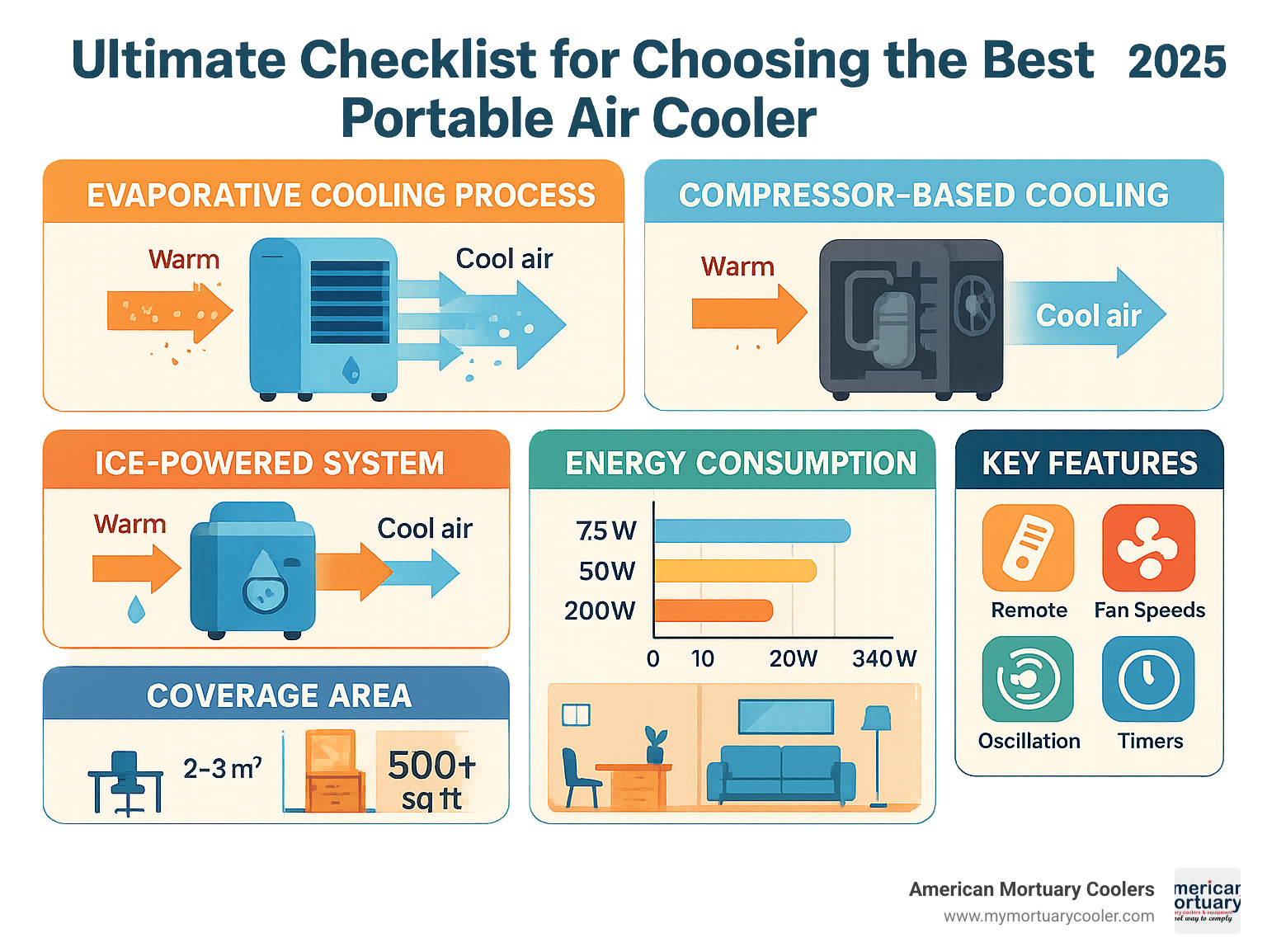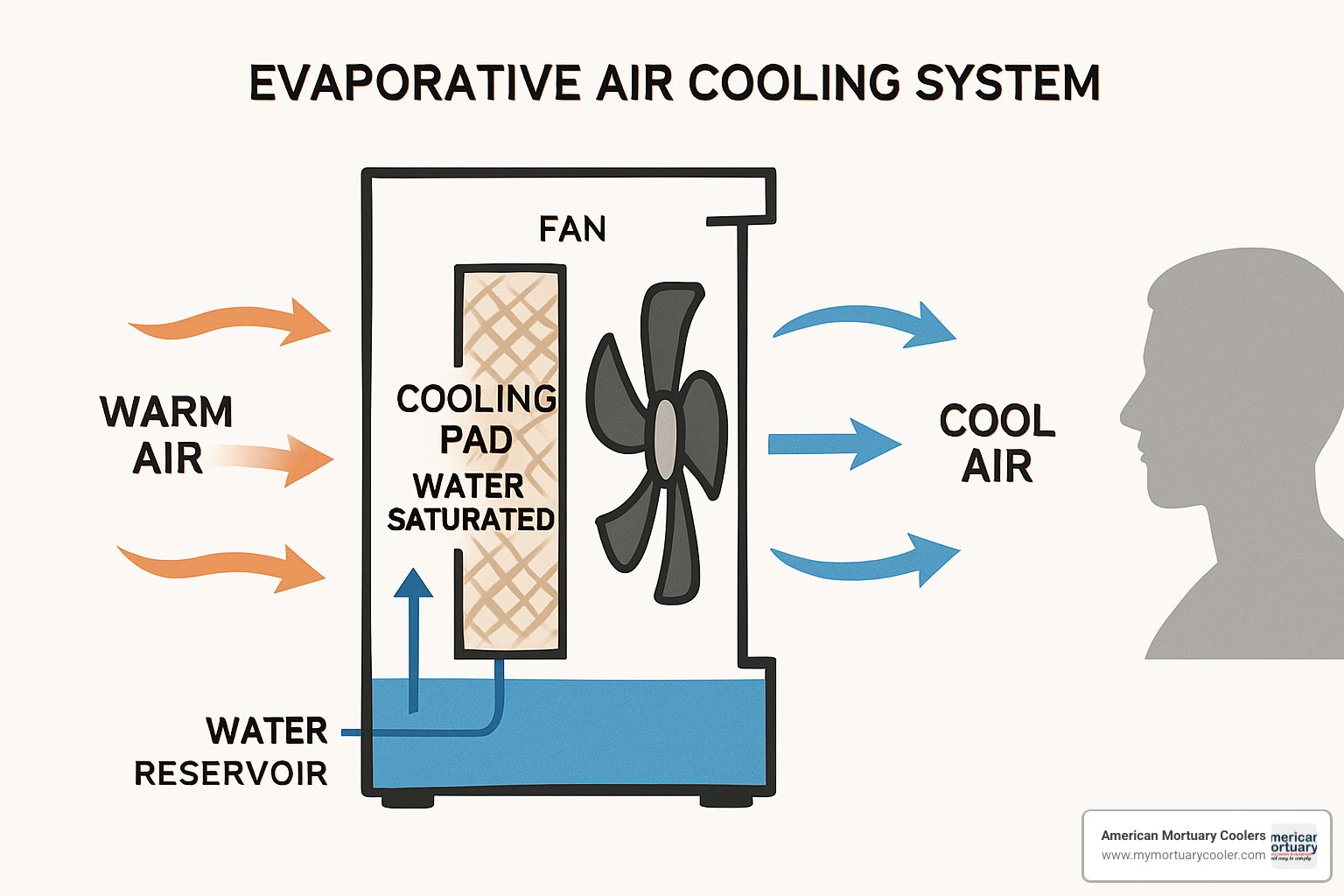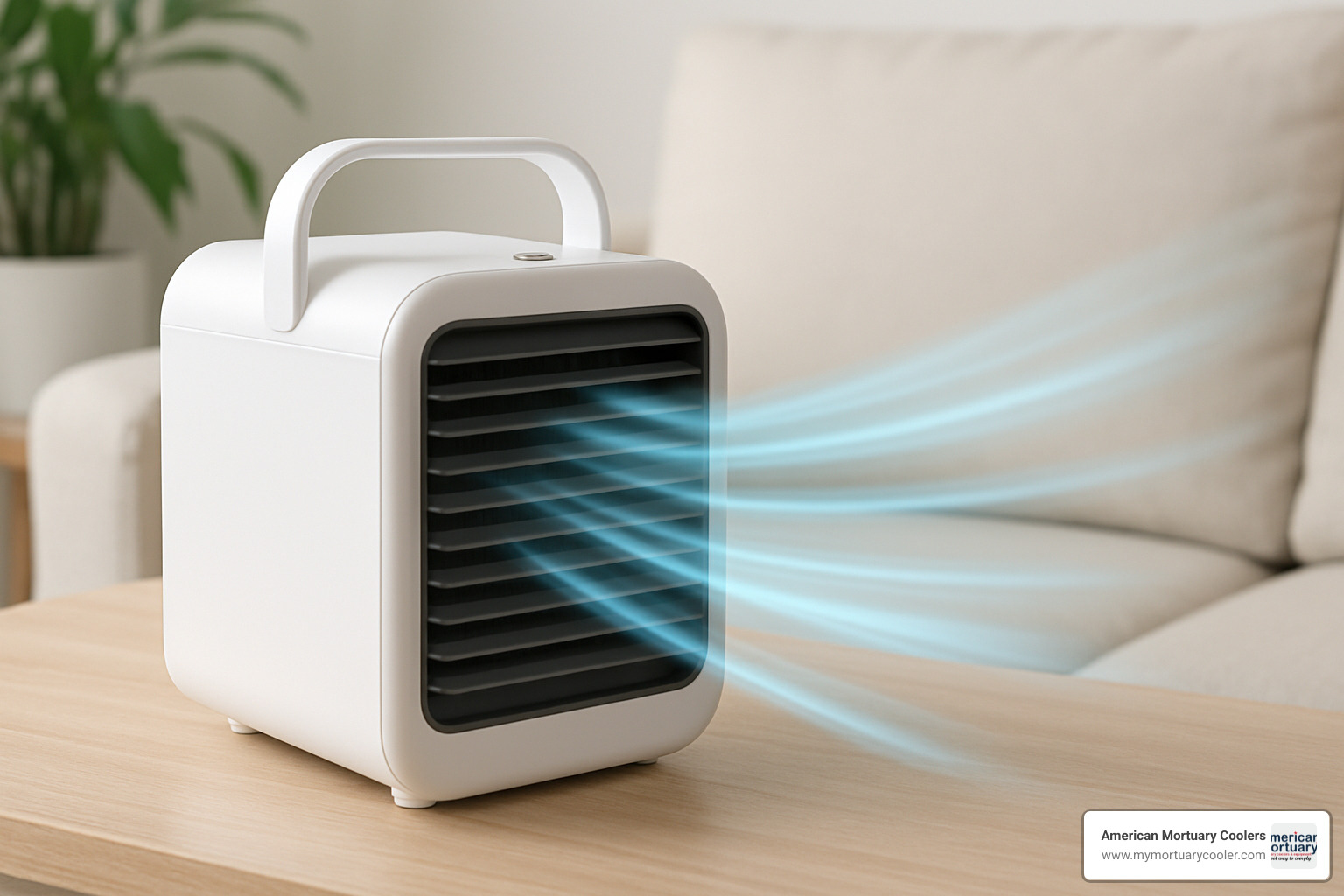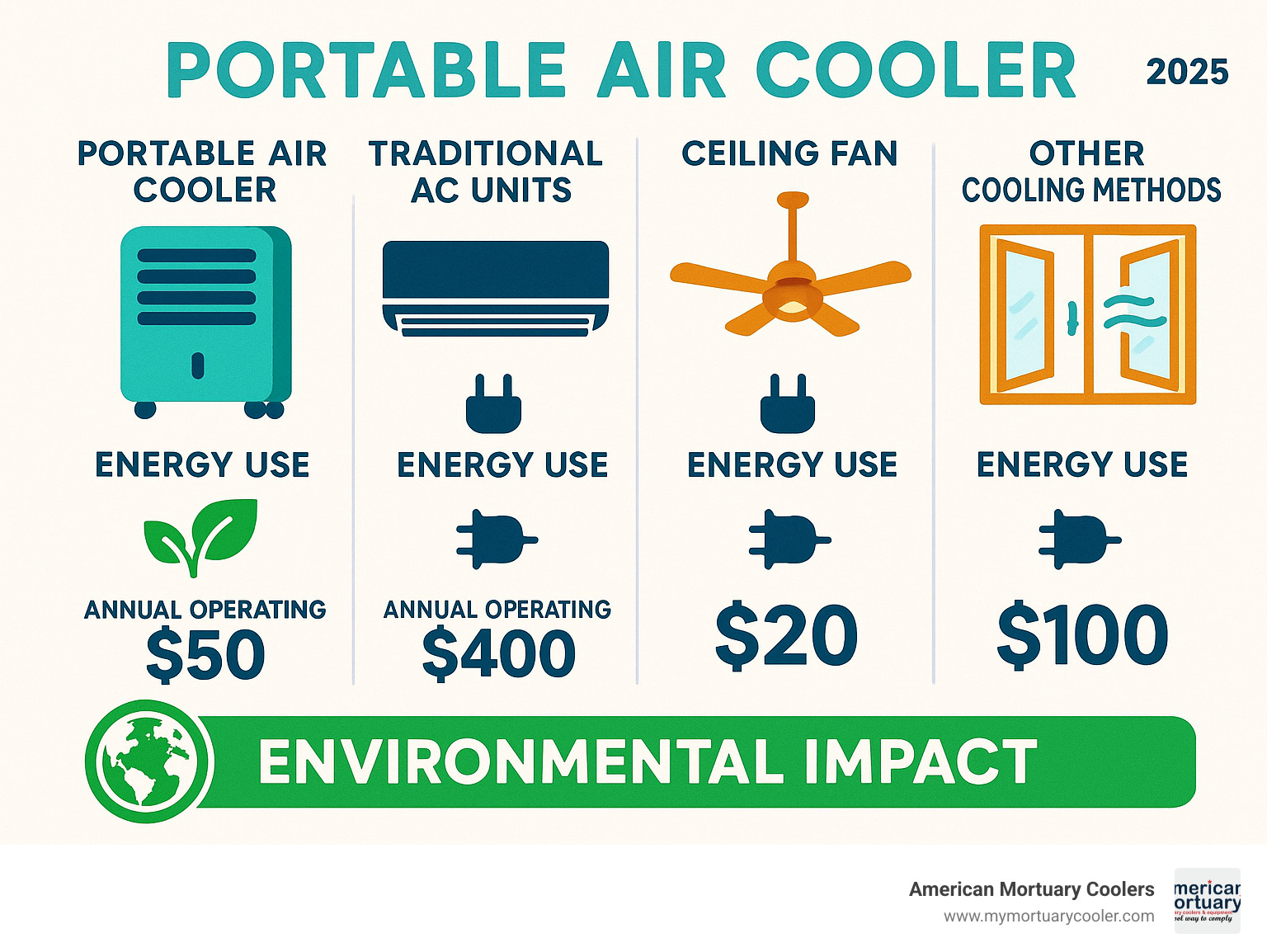Why Portable Air Coolers Are Game-Changers for Spot Cooling
A portable air cooler is an energy-smart alternative to whole-house AC. By relying on water evaporation, ice, or a compact compressor, these units create a personal comfort zone while using only a fraction of the electricity demanded by traditional systems.
Key portable air cooler types:
- Evaporative coolers – water-soaked pads drop air temperature 5-15 °F; best in dry climates
- Ice-powered units – deliver air up to 35 °F cooler using ice and water
- Compressor-based mini ACs – real refrigeration in a portable shell, roughly 70 % more efficient than standard portable ACs
- Coverage – personal 2 m² zones up to 500 sq ft rooms
- Power draw – 7.5 W USB models to 340 W pro units
- Price range – $24 desk coolers to $725 heavy-duty ice chests
Running a 340 W Coolzy-Pro for eight hours costs under $1, whereas a 1,800 W portable AC can cost about $4 for the same period.
At American Mortuary Coolers, we’ve learned that focusing cooling exactly where it’s needed—whether beside a mortuary prep table or at your home workstation—keeps both comfort and operating costs in check.

Portable Air Cooler Basics: How They Work & Key Types
Let's explore portable air cooler technology. Think of it this way - while your home's AC system is like heating an entire swimming pool, a portable air cooler is more like filling up a refreshing kiddie pool right where you need it most.
Understanding how different cooling technologies work will help you pick the perfect unit for your space. Each type has its own personality and works best in different situations.

What Is a Portable Air Cooler?
A portable air cooler is basically a smart fan that teams up with water, ice, or mini refrigeration to create your personal cool zone. Instead of trying to chill your entire house like traditional AC, these clever devices focus on keeping you comfortable wherever you happen to be.
The magic happens when warm air gets pulled through some kind of cooling system - whether that's wet pads, ice, or tiny refrigeration coils - then gets blown right back at you at a much more pleasant temperature. It's like having a personal weather system that follows you around.
This targeted approach makes these units incredibly efficient. Why waste energy cooling empty rooms when you can just cool the space around your desk, bed, or favorite reading chair?
Main Categories Explained
Evaporative Coolers (Swamp Coolers)
These are the workhorses of the portable air cooler world. They work on the same principle that makes you feel chilly when you step out of a swimming pool on a breezy day. Warm air gets pulled through water-soaked pads, and as that water evaporates, it steals heat from the air.
The scientific research on evaporative cooling shows these units can drop air temperature by 10-15°F when conditions are right. They work best in dry climates where the air is thirsty for moisture.
You'll find evaporative coolers with tank capacities ranging from tiny 0.5-liter personal units to hefty 4.2-gallon room coolers. Their airflow can push anywhere from 200 CFM for desktop models up to 1,800 CFM for serious room coverage. The beauty is they only use 7.5W to 300W of power while covering 50 to 1,600 square feet.
Ice-Powered Coolers
Now we're talking serious cooling power. Units like the IcyBreeze are like having a portable winter day. They use a clever heat-exchange system powered by ice and water that can blast air up to 35°F cooler than whatever Mother Nature is throwing at you.
These are the heroes of camping trips, tailgate parties, and outdoor work sites. Plus, they pull double duty by keeping your drinks cold while they're busy keeping you cool.
Compressor-Based Mini ACs
The Coolzy-Pro and similar units bring real refrigeration technology to the portable party. These little powerhouses use actual R134a refrigerant and compressors, just like your full-size AC, but in a package you can actually move around.
Here's where the numbers get impressive: they use about 340W of electricity while delivering 1,100W of cooling capacity. That's roughly 70% less power than standard portable ACs. No water to refill, no pads to clean - just plug in and enjoy the chill.
Hybrid Fan-Purifiers
The overachievers of the bunch, units like the evaLIGHT plus refuse to do just one job. They cool your air, clean it, and add just the right amount of moisture if your space is too dry. These multi-taskers combine evaporative cooling with air filtration, making them perfect for year-round comfort.
The humidity factor is crucial to understand with any portable air cooler. Evaporative models add moisture to the air, which feels great in dry climates but can make humid areas feel sticky. CFM airflow ratings tell you how much air the unit can move, while tank capacity determines how long you can run before refilling.
Portability features like wheels, carrying handles, and lightweight designs make the difference between a cooling solution and a cooling headache. The best units balance power with practicality, so you actually want to move them where you need them most.
Ultimate Buying Checklist for the Best Portable Air Cooler
Shopping for the perfect portable air cooler can feel overwhelming with thousands of options available. After helping countless customers find the right cooling solutions, we've learned what really matters when making this decision.
The most important factor? Matching your cooler's airflow capacity to your space size. A personal desk cooler pushing 200 CFM won't effectively cool a 500-square-foot room, while a powerful 1,800 CFM unit would be overkill (and noisy) for bedside use.

Room size determines everything else. For personal spaces under 50 square feet, look for units with 200-400 CFM airflow. Medium rooms up to 300 square feet need 500-800 CFM, while larger areas require 1,000+ CFM units. Don't forget to consider ceiling height - taller rooms need more powerful airflow to circulate cooled air effectively.
Tank capacity directly impacts your daily routine. Small 0.5-liter tanks in personal units need refilling every 3-4 hours, which works fine for desk use but becomes annoying for overnight cooling. Room-sized coolers with 2-4 gallon tanks can run 15-20 hours between fills, making them much more practical for continuous use.
Power consumption varies dramatically across different portable air cooler types. USB-powered personal units draw just 7.5-10 watts, perfect for battery packs or laptop charging. Mid-range evaporative coolers typically use 100-200 watts, while professional units like the Coolzy-Pro consume 340 watts but still use 70% less electricity than traditional portable ACs.
Portable Air Cooler Must-Have Features
Remote controls and smart features have become standard on quality units. The CENSTECH 4-in-1 includes a 17-foot range remote with multiple fan speeds, oscillation controls, and timer functions up to 15 hours. Many newer models offer smartphone app connectivity, though we find physical remotes more reliable for daily use.
Auto-shutoff when water runs low prevents your cooler from running dry and potentially damaging the pump. This feature also saves energy by stopping the fan when cooling effectiveness drops to zero.
Continuous-fill hookups transform room coolers into set-and-forget appliances. Units with garden hose connections eliminate the refill routine entirely, though you'll want to ensure proper drainage to prevent overflow.
Filter types matter more than most people realize. Basic foam filters need weekly cleaning, while advanced multi-stage filters with antimicrobial treatments can run 2-3 months between replacements. Some units include UV sterilization to prevent bacteria growth in the water tank.
Climate & Use-Case Fit
Your local humidity makes or breaks evaporative cooling performance. These units work brilliantly in arid climates with humidity below 60%, but struggle in muggy conditions where the air already holds maximum moisture. If you live in a humid area, consider compressor-based units like the Coolzy-Pro instead.
Bedroom cooling requires special attention to noise levels. Look for units rated under 50 decibels - about as quiet as a refrigerator hum. The Arctic Air Pure Chill 2.0 runs whisper-quiet at night mode, while larger units often include sleep settings that reduce fan speed after sunset.
Office desk cooling works best with compact units covering 2-3 square meters with USB power compatibility. You'll want oscillation features to distribute airflow without creating uncomfortable direct drafts on paperwork or computer screens.
Camping and outdoor use demands rugged construction and off-grid power options. Ice-powered units like the IcyBreeze excel here, combining cooling with beverage storage while running on battery or solar power. Weather-resistant construction protects against dust and moisture.
Price Breakdown & Value Spots
Under $50 gets you reliable personal cooling. The Arctic Air Pure Chill 2.0 at $24.25 delivers solid performance for desk or bedside use with USB power and whisper-quiet operation. These units cover 2-3 square meters effectively but won't cool larger spaces.
The $100-$300 range offers the best value for most households. Units like the BLACK+DECKER Desktop Air Cooler and Dreo 40" Evaporative Air Cooler provide remote controls, multiple speeds, oscillation, and timer functions while covering 200-500 square feet. This price range includes most features you'll actually use daily.
Professional units above $400 target specific applications. The Coolzy-Pro Portable AC at $399 uses actual refrigeration technology for humid climates, while the IcyBreeze CL-50R at $725 combines ice-powered cooling with rugged outdoor construction and off-grid capability.
For specialized cooling applications requiring custom solutions, our comprehensive guide to choosing the right cooler covers additional factors to consider when standard options won't meet your needs.
Performance & Efficiency: Portable Air Cooler vs ACs & Fans
Let's get real about what a portable air cooler can actually do for you. After helping funeral directors manage temperature control in challenging environments for years, we've learned that understanding realistic performance expectations is crucial for making smart cooling decisions.
Cooling Capacity Reality Check
Temperature Drop Expectations
Here's what you can actually expect from different types of cooling units. Evaporative coolers typically reduce air temperature by 5-15°F, but this works best when humidity stays below 60%. Think of those hot, dry summer days in Arizona – that's when these units really shine.
Ice-powered units are the heavy hitters, dropping temperatures by up to 35°F. We've seen contractors use these on job sites where the difference between comfortable and miserable can make or break a workday.
Compressor-based units like the Coolzy-Pro give you the most control. They work more like traditional air conditioners, letting you set an exact temperature rather than just hoping for the best.
Coverage Area Guidelines
The relationship between CFM (cubic feet per minute) and actual cooling coverage is pretty straightforward once you know the math. A unit pushing 200 CFM will effectively cool about 50 square feet – perfect for your desk area or a small bedroom corner.
Step up to 1,000 CFM and you're looking at roughly 250 square feet of coverage. For serious cooling power, units like the 1800 CFM Swamp Cooler can handle up to 500 square feet while still keeping energy costs reasonable.
Microclimate Focus
Here's something most people don't realize: portable air coolers work best when you position them within 3-5 feet of where you're sitting or working. They're designed for personal comfort zones, not whole-room cooling like central air systems.
This targeted approach actually makes them incredibly efficient. Instead of wasting energy cooling empty spaces, you're putting all that cooling power exactly where you need it most.
Pros & Cons Summary
The Good News
Your electricity bill will thank you. Most portable air coolers use 70-90% less energy than traditional AC units. We're talking about $1 per night instead of $4 for the same comfort level.
There's no refrigerant to leak or expensive maintenance calls to schedule. These units are refreshingly simple – add water, plug in, and enjoy the cool air. The evaporative types even add helpful moisture to dry indoor air.
The Reality Check
High humidity kills the performance of evaporative coolers. If you live somewhere muggy like Florida in August, you'll want to consider a compressor-based unit instead.
You'll need to refill water tanks regularly – anywhere from every few hours for small units to once a day for larger models. Some people find this annoying, but we think it's a fair trade-off for the energy savings.
These units create personal comfort zones rather than cooling entire rooms. If you need to chill a whole house, central air is still your best bet.

Maintenance, Safety & FAQs for Your Portable Air Cooler
Taking care of your portable air cooler doesn't have to be complicated, but a little regular attention goes a long way. Think of it like tending a small garden - consistent care keeps everything running smoothly and extends the life of your investment.
Daily maintenance is surprisingly simple. Check your water level before each use, especially on hot days when evaporation happens faster. Weekly cleaning involves wiping down the exterior and checking for any mineral buildup around the water tank. The real work happens monthly when you'll want to descale the unit using a mild vinegar solution and replace any evaporative pads that look worn or discolored.
Cartridge changes depend on your water quality and usage frequency. In areas with hard water, you might need fresh pads every 3-4 weeks during heavy use. Softer water areas can often stretch this to 6-8 weeks. Your nose will tell you when it's time - musty odors mean it's definitely time for fresh media.
Safe water practices matter more than most people realize. Always use fresh water, never let stagnant water sit for days, and consider adding a few drops of bleach to larger tanks if you're storing the unit between seasons. Child and pet safety is straightforward - keep electrical cords away from water and ensure units are stable and won't tip over.
Troubleshooting leaks usually comes down to checking tank seals and ensuring the unit sits level. Most "leaks" are actually condensation that can be managed with proper ventilation. Cross-ventilation helps tremendously - crack a window or door opposite your cooler to let humid air escape while drawing in fresh air.
Warranty basics vary by manufacturer, but most reputable brands offer 1-2 year coverage on electrical components. Keep your receipt and register your product online if possible.
FAQ #1 – How often should I refill or hook up water?
This depends entirely on your unit size and how hard you're working it. Personal units with those tiny 0.5-1 liter tanks need attention every 3-9 hours - think of refilling them like charging your phone. Room-sized units with 2-4 gallon tanks give you breathing room, typically running 15-20 hours before needing a top-off.
Continuous fill hookups are a game-changer if you're using your cooler regularly. Many units accept standard garden hose connections, turning your portable air cooler into a set-it-and-forget-it appliance. Just remember to check for proper drainage if you're running continuously - you don't want to flood your space.
The low-water alarms on newer models take the guesswork out of timing. When that light starts blinking or the beeping begins, you've got maybe 30 minutes before the unit shuts down to protect the pump.
FAQ #2 – Are portable air coolers noisy at night?
Noise levels vary dramatically, and this is where reading reviews really pays off. Whisper-quiet units running under 25 dB are barely audible - think quieter than a library. Sleep-friendly models in the 25-45 dB range sound like gentle white noise that many people find soothing.
Room units on high speed can hit 45-60 dB, which is more like having a conversation in the room. For bedroom use, look for units with multiple speed settings so you can dial down the fan at night while still getting gentle air movement.
The type of cooling technology affects noise too. Evaporative coolers tend to be quieter than compressor-based units, though the trade-off is cooling power in humid conditions.
FAQ #3 – Can I run a portable air cooler off-grid with batteries or solar?
Absolutely, and this is where portable air coolers really shine compared to traditional AC units. USB-powered personal units consuming just 7.5-10 watts can run 8-12 hours on a decent power bank - perfect for camping or power outages.
Higher-power units need more planning but are totally doable. A unit like the Coolzy-Pro at 340 watts can run on 12V battery systems with a proper inverter, though you'll want at least a 100Ah battery for meaningful runtime. Solar panel systems work great if you have at least 400 watts of panels and good sun exposure.
Battery runtime calculations are straightforward once you know the math. A 100Ah 12V battery gives you about 1,200 watt-hours of capacity. Divide that by your cooler's wattage, and you'll get approximate runtime - though real-world results are usually 10-20% lower due to inverter losses.
For more detailed information about selecting cooling equipment for specialized applications, our comprehensive guide to choosing the right cooler covers additional considerations for professional and commercial use.
Best Portable Air Coolers & Innovations to Watch in 2024
After analyzing over 30,000 available models and thousands of customer reviews, we've identified the portable air cooler units that truly deliver on their promises. These standout performers represent the best balance of cooling power, reliability, and value in today's market.
The personal cooling category is dominated by three exceptional units. The CENSTECH 4-in-1 leads the pack with an impressive 4.9 out of 5 stars from 101 customers, offering remote control convenience and multiple cooling modes that adapt to your needs throughout the day. The BLACK+DECKER Desktop model has proven its reliability with over 8,385 customer reviews and a solid 4.5-star rating – plus it's flying off the shelves with 400+ units sold monthly. For budget-conscious buyers, the Arctic Air Pure Chill 2.0 has earned trust from 17,865 customers and maintains strong sales of 500+ units per month.
When you need serious cooling power, the professional tier delivers impressive results. The Coolzy-Pro stands out by offering true refrigeration cooling while consuming just 340W – that's genuine AC performance without the massive energy bills. For outdoor enthusiasts, the IcyBreeze CL-50R combines a 50-quart cooler with ice-powered air conditioning, making it perfect for camping trips and job sites. The Dreo 40" Tower rounds out this category with 4.0 stars from 426 reviews and steady monthly sales of 200+ units.
Smart Technology Revolution
The 2024 portable air cooler market is experiencing a technology boom that's making these devices smarter and more convenient than ever. Modern units now include humidity sensors that automatically adjust cooling intensity based on current conditions – no more guessing whether your cooler is working optimally.
Smartphone app integration has transformed how we control our cooling comfort. You can now schedule your cooler to start before you arrive home, adjust settings from across the room, or even monitor water levels remotely. Voice control compatibility with Alexa and Google Assistant means you can adjust your cooling with simple voice commands while your hands are full.
Health-Focused Innovations
Air quality has become a major focus for manufacturers, leading to impressive filtration improvements. UV-sterilizing filters now eliminate bacteria and viruses from the air while cooling, making these units perfect for health-conscious households. Antimicrobial evaporative pads prevent mold and bacteria growth within the unit itself, while HEPA filtration in hybrid models captures dust and allergens.
Beyond Just Cooling
Today's portable air cooler units are becoming entertainment and utility hubs. The Coolee CL-240 series includes built-in Bluetooth speakers, so you can enjoy music while staying cool. Some models now feature power bank functionality to charge your devices, while LED mood lighting with customizable colors creates the perfect ambiance for any situation.

Smart Shopping Strategy
The market has settled into three distinct price tiers that make shopping easier. Entry-level units ($24-$50) offer basic evaporative cooling with manual controls – perfect for trying out portable cooling without a big investment. Mid-range models ($100-$300) include the convenience features most people want: remote controls, oscillation, and larger water tanks for longer runtime. Professional units ($400-$725) deliver true AC cooling performance, ice-powered systems, and outdoor-rated durability.
Customer satisfaction data reveals an interesting sweet spot – most buyers find their perfect match in the $100-$200 range. This price point delivers reliable cooling performance plus convenient features like remote controls and timers, without paying for professional features you might not need.
At American Mortuary Coolers, we've learned that the best cooling solution is the one that fits your specific needs and budget. Whether you're looking for personal comfort at your desk or powerful cooling for outdoor work, 2024's portable air cooler innovations offer something for everyone.
Conclusion & Next Steps
Finding the perfect portable air cooler comes down to understanding your unique situation and matching it with the right technology. After reviewing dozens of models and analyzing thousands of customer reviews, we've seen that the happiest buyers are those who take time to consider their specific needs before purchasing.
Your climate makes the biggest difference. If you live in a dry area like Arizona or Nevada, evaporative coolers will give you excellent results at rock-bottom operating costs. But if you're dealing with Florida humidity, you'll want to invest in a compressor-based unit like the Coolzy-Pro that actually removes moisture from the air.
The sweet spot for most people falls in that $100-$200 range where you get reliable cooling performance without breaking the bank. You'll have remote controls, decent tank capacity, and features like oscillation and timers that make daily use convenient.
At American Mortuary Coolers, we've spent years helping funeral directors across Tennessee, Georgia, and beyond find cooling solutions that work reliably when they need them most. While our day job involves keeping mortuary equipment running smoothly, we understand that effective cooling principles apply everywhere - whether you're trying to stay comfortable at your desk job or need relief during a hot camping trip.
The technology keeps getting better too. We're seeing units with smartphone apps, voice control, and even built-in air purification. Some newer models like the CENSTECH 4-in-1 pack multiple functions into one device, giving you more value for your investment.
Don't overthink it though. Start with our checklist - figure out your coverage area, check your climate type, and set a realistic budget. Most people find that a mid-range evaporative cooler handles their needs perfectly while using about as much electricity as a bright light bulb.
For specialized applications where you need industrial-grade portable cooling solutions, our comprehensive guide to choosing a portable body cooler covers additional options that might interest you.
The bottom line? A good portable air cooler can transform how comfortable you feel during hot weather without the sticker shock of running traditional air conditioning all day. Whether you go with a $25 personal unit for your nightstand or invest in a $400 professional model for serious cooling power, you're making a smart choice for both your comfort and your wallet.


















